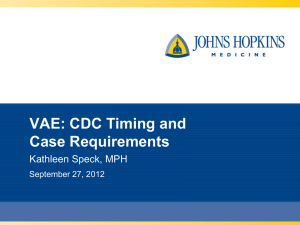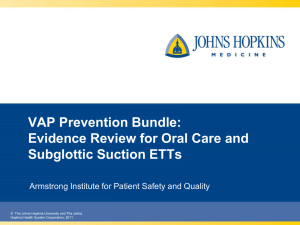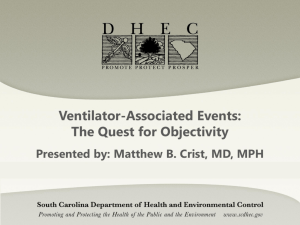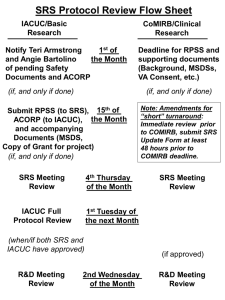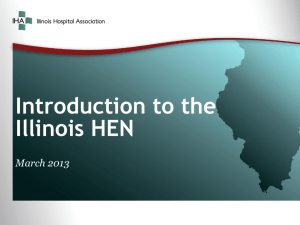Slide - community360.net
advertisement
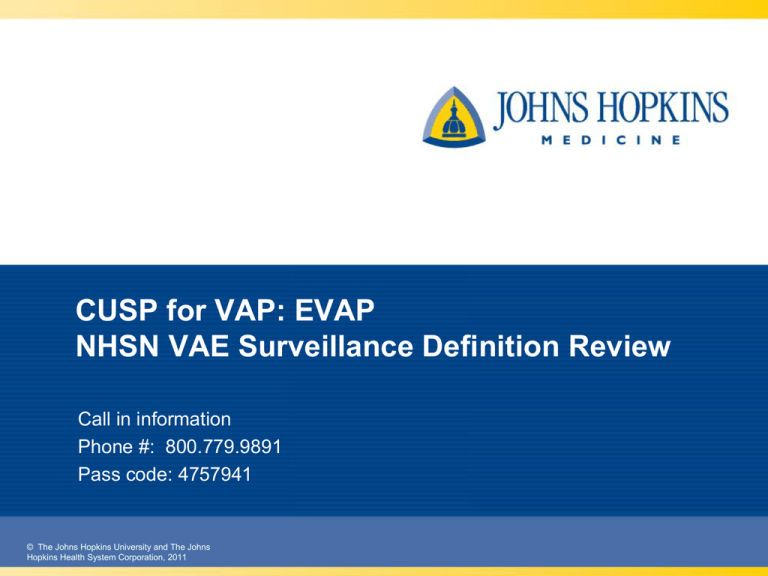
CUSP for VAP: EVAP NHSN VAE Surveillance Definition Review Call in information Phone #: 800.779.9891 Pass code: 4757941 © The Johns Hopkins University and The Johns Hopkins Health System Corporation, 2011 CUSP for VAP: EVAP NHSN VAE Surveillance Definition Review Presented by: Kathleen Speck, MPH September 13, 2012 Armstrong Institute for Patient Safety and Quality © The Johns Hopkins University and The Johns Hopkins Health System Corporation, 2011 Our Collaborators – Karol G. Wicker, MHS Senior Director, Quality Policy & Advocacy Maryland Hospital Association kwicker@mhaonline.org – Mary Catanzaro RN BSMT CIC Project Manager HAIs Hospital and Healthsystem Association of Pennsylvania mcatanzaro@haponline.org 3 Learning Objectives • To discuss the NHSN VAE definition. • To discuss the linelist generator developed by Dr. Michael Klompas 4 Armstrong Institute for Patient Safety and Quality NHSN Surveillance 2012-2013 • Assessment must take place for all VAE tiers – VAC - Ventilator-associated Condition – IVAC - Infectious Ventilator-associated Condition – Possible Ventilator-associated Pneumonia – Probable Ventilator-associated Pneumonia 5 Armstrong Institute for Patient Safety and Quality VAC Definition Criteria8 • Patient intubated for > 2 calendar days • Baseline stability – Baseline: • 2 calendar days immediately preceding the first day of increased daily minimum PEEP or FiO2 requirements – Stability: • ≥ 2 calendar days of stable or decreasing daily minimum FiO2 or PEEP requirements 6 Armstrong Institute for Patient Safety and Quality Threshold change for VAC • Threshold rise in daily minimum: – PEEP by ≥3 cm H2O or – FiO2 by ≥20 points – sustained ≥2 days 7 Armstrong Institute for Patient Safety and Quality Example - VAC Stable 8 Armstrong Institute for Patient Safety and Quality Example – no VAC Unstable 9 Armstrong Institute for Patient Safety and Quality Example – no VAC 10 Armstrong Institute for Patient Safety and Quality Subsequent VAEs • VAEs are defined as 14 days – Starts on day 1 of worsening oxygenation – New VAE cannot be reported until 14 day period has elapsed 11 Armstrong Institute for Patient Safety and Quality VAE Outcomes • VAE = VAC, IVAC, Possible VAP and Probable VAP • VAC = Significant respiratory deterioration after 2 or more days of stability • IVAC = VAC + abnormal temp or WBC + ≥ 4 days of new antibiotics • Possible VAP = IVAC + purulent sputum or positive sputum/BAL culture • Probable VAP = IVAC + purulent sputum AND positive sputum/BAL culture 12 Armstrong Institute for Patient Safety and Quality Setting Up a Linelist 13 Armstrong Institute for Patient Safety and Quality Linelist Definitions 14 Armstrong Institute for Patient Safety and Quality Steps to generate linelist for VAE • Begin with “Daily Linelist” • Enter daily minimum PEEP and FiO2 for every ventilated patient for every calendar day the patient spends any time on a ventilator • Worksheet will automatically flag events that fulfill criteria for VAC • If a patient is not identified as having VAC, don’t collect any further information for that patient. 15 Armstrong Institute for Patient Safety and Quality Step 1 – VAC 16 Armstrong Institute for Patient Safety and Quality Determination of IVAC • Patients where VAC has already been determined • Enter: – Tmin and Tmax – WBCmin and WBCmax – QAD – Qualifying antibiotic day • IVAC requires 4 contiguous days of a new antibiotic starting within the 5 days starting 2 days before the onset 17 Armstrong Institute for Patient Safety and Quality Step 2 - IVAC 18 Armstrong Institute for Patient Safety and Quality New Antimicrobial Agent Qualifying Antimicrobial Day (QAD) • Any agent listed in the Appendix of the Device Associated Events: VAE (pages 10-19 through 10-21) that: – Is initiated on or after the third day of mechanical ventilation AND – is started in the 5 day period defined by • 2 days before • the day of the event • the 2 days after AND – Was not given to the patient on either of the two days preceding the current event 19 Armstrong Institute for Patient Safety and Quality Qualifying Antibiotic Days - Timing (VAC has already been established) 20 Armstrong Institute for Patient Safety and Quality Example Antibiotic Worksheet 21 Armstrong Institute for Patient Safety and Quality Determination of Possible VAP or Probable VAP • Patients where IVAC has been determined • From Sputum of BAL gram stain – Enter • Polys – polys, neutrophils or WBC (semiquantitative scale) • Epis – epithelial cells or squamous cells (semiquantitative scale) • Culture – result • Quantity - threshold (10^5 for endotracheal aspirate, 10^4 for BAL, 10^3 for protected specimen brush). Semi-quantitative equivalent also acceptable. Answer Yes or No. 22 Armstrong Institute for Patient Safety and Quality Step 3 – Possible VAP or Probable VAP 23 Armstrong Institute for Patient Safety and Quality • Questions? 24 Armstrong Institute for Patient Safety and Quality



